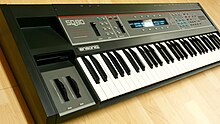| SQ-80 | |
|---|---|
 Ensoniq SQ-80, featuring the 8tr multi-timbral pattern sequencer with a FD drive Ensoniq SQ-80, featuring the 8tr multi-timbral pattern sequencer with a FD drive | |
| Manufacturer | Ensoniq |
| Dates | 1987 - 1989 |
| Technical specifications | |
| Polyphony | 8 voices |
| Timbrality | 8 |
| Oscillator | 3× single-cycle wavetable-lookup oscillators per voice, 43 additional waveforms (including 5 drum-kit) |
| LFO | 3 per voice |
| Synthesis type | Cross Wave Synthesis (hybrid: digital wavetable-lookup oscillator / analog filter) |
| Filter | 1 analog filter per voice |
| Attenuator | 4 Envelope - Four levels, four rates |
| Aftertouch expression | Yes (polyphonic) |
| Velocity expression | Yes |
| Effects | None |
| Input/output | |
| Keyboard | 61 keys, split or layered |
| Left-hand control | Pitch bend, mod wheel |
| External control | MIDI |
The Ensoniq SQ-80 is a digital/analog synthesizer manufactured from 1987 to 1989. It was Ensoniq's update to its first synth, the Ensoniq ESQ-1.
Compared to the ESQ-1, the SQ-80 includes 43 additional waveforms (including five drumkits), an enhanced sequencer, and a floppy disk drive for storing patches and sequences. Synthesis-wise, the SQ-80 introduced the so-called 2nd Release, a low-cost solution to simulate reverb-like effects. In contrast to the ESQ-1, the SQ-80 not only offers MIDI in and out, but also MIDI thru jacks.
The SQ-80 was the first Ensoniq product to feature their patented Polypressure Keyboard technology. Unlike the ESQ-1 and Mirage, the SQ-80's keyboard offers channel pressure and polyphonic pressure (aftertouch) as well as programmable hardness (velocity). Since the keyboard does not use mechanical sensors for detecting velocity and pressure, it is immune to contact problems (which ESQ-1 and Mirage suffered from) and pressure sensor wear-out (like conventional keyboards).
Because of the hardware similarities, the SQ-80's operating system was later back-ported to the ESQ-1 to become the latest ESQ-1 OS Version 3.5, which is almost identical to SQ-80 OS 1.8 apart from the hardware-specific features (additional waveforms, floppy routines, and keyboard control).
This machine also features the same interface as its predecessor (ESQ-1) at a time when other synthesizers were getting harder and harder to program due to their frustrating obscure menu navigation systems. On the SQ-80 and ESQ-1, a large fluorescent display consisting of two rows of 40 alpha-numeric characters shows many parameters at once for a given section, and buttons placed over and under it give instant access to each one.
Notable users
| This section does not cite any sources. Please help improve this section by adding citations to reliable sources. Unsourced material may be challenged and removed. (April 2010) (Learn how and when to remove this message) |
- Adamski – 1989–1991 recording sessions ("Killer" single) all tracks on Liveandirect (album)
- Louis Panzer - Nocturnus
- Mr. Bungle - Mr. Bungle (1991)
References
- "Vintage Synth Explorer".
- Adamski ft. Seal - 'Killer' Deconstruction in Ableton + Adamski Interview. Retrieved 2024-04-05 – via www.youtube.com.
- "Copia Verborum". Trevor Dunn. 2022-08-17. Retrieved 2024-04-05.
- Bibliography
- "Ensoniq SQ80 Workstation Synth". Sound on Sound (July 1996).
- Ensoniq SQ-80 Cross Wave Synthesizer and Sequencer - Musicians Manual Version 1.0 (PDF). Ensoniq. 1987-1995. Model # MM-15, Part # 9310 0025 01-B.
About Cross WaveSynthesis (p.29) The sound of most musical instruments can be separated into two basic parts: • The Attack ... • The Sustain ... Ideally, we would like to be able to sample (digitally record) the Attack segments of various sounds, and then Crossfade those Attacks with other sampled or synthesized Sustain Waves. ... Within each Program, each of the SQ-80's three Oscillators can play a different Wave. Among the available Waves are Transient Attacks, which are used for the initial Attack portion of the sound, and two types of Sustain Waves — Waveforms, which are single-cycle waves repeated over and over, and Inharmonic Loops, which are dynamic. multi-cycle waves.
Further reading
- "Ensoniq SQ-80". Sound on Sound. February 1988. pp. 8–12. ISSN 0951-6816. OCLC 925234032.
External links
- Rainer Buchty's Ensoniq Heaven (support community), including a VST emulator of the machine
- ESQ/SQ-80 Resource Page - Step-by-step sound design specifically for the ESQ-1 and SQ-80 series
This article relating to electronic musical instruments is a stub. You can help Misplaced Pages by expanding it. |